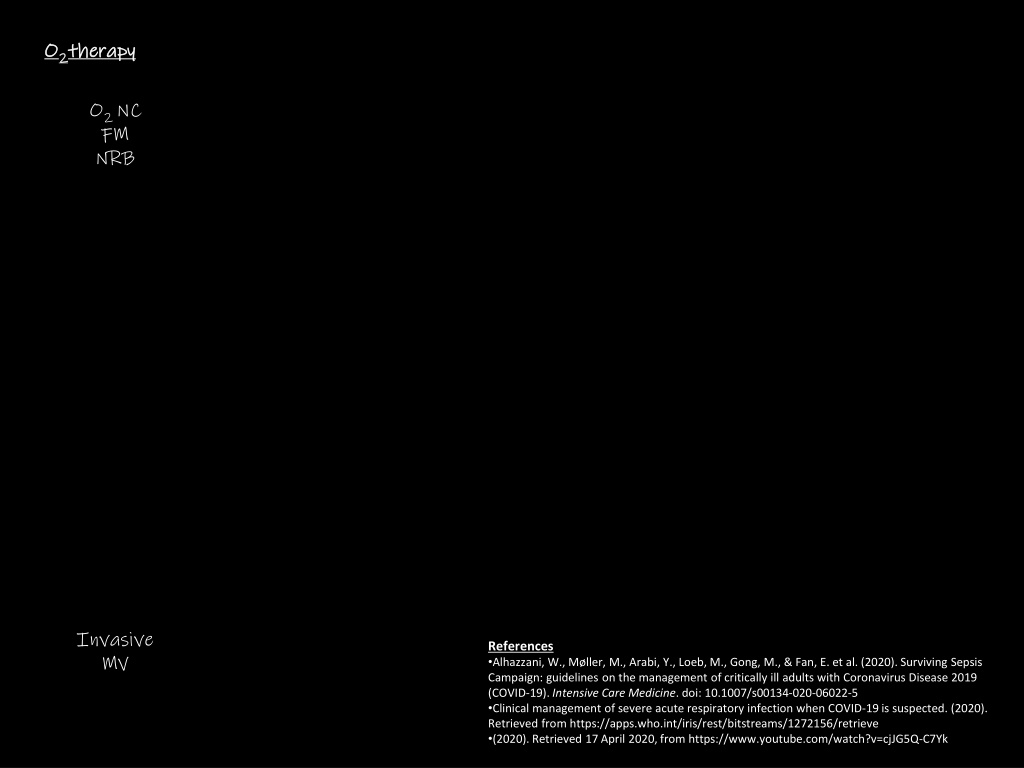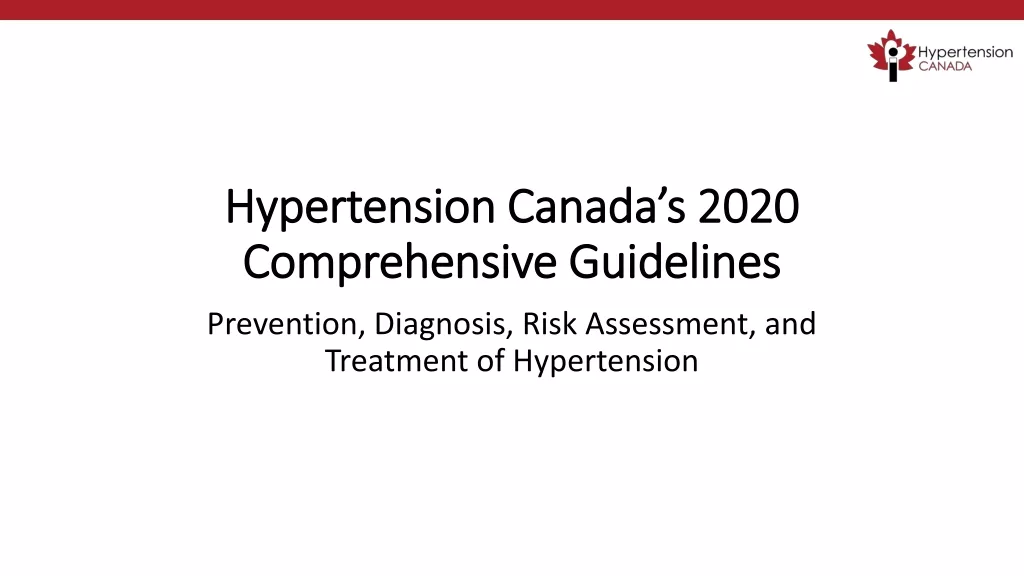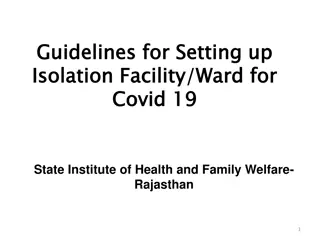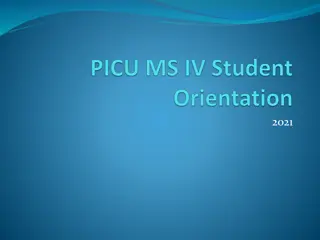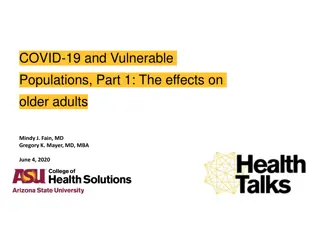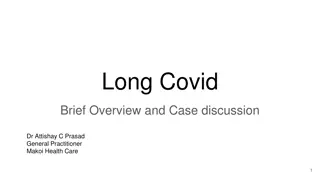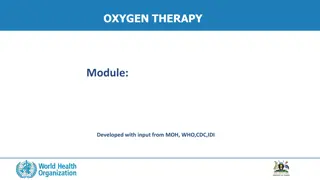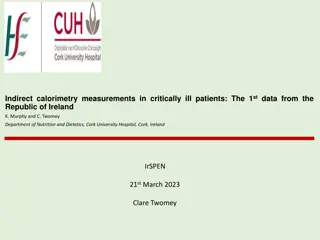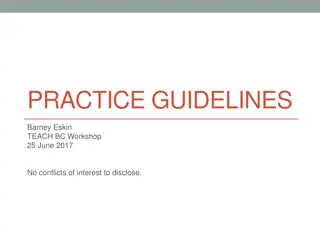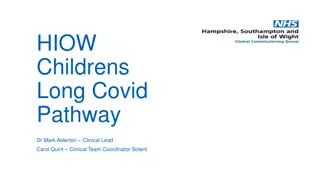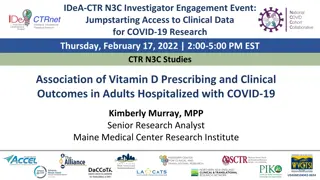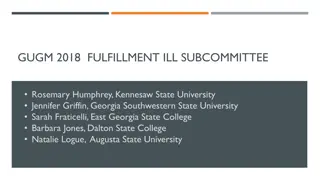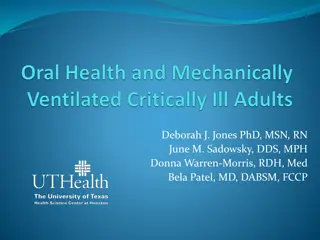Clinical Management Guidelines for Critically Ill Adults with COVID-19
The guidelines focus on managing severe acute respiratory infections suspected to be COVID-19, covering oxygen supplementation starting recommendations, SpO2 targets, use of HFNC and NIPPV, risk of aerosol transmission, initial ventilator settings, troubleshooting, and the transition to invasive mechanical ventilation. Emphasis is placed on close monitoring, early intervention, and minimizing risks to healthcare providers. Ref: Alhazzani et al. (2020).
Download Presentation

Please find below an Image/Link to download the presentation.
The content on the website is provided AS IS for your information and personal use only. It may not be sold, licensed, or shared on other websites without obtaining consent from the author. Download presentation by click this link. If you encounter any issues during the download, it is possible that the publisher has removed the file from their server.
E N D
Presentation Transcript
O O2 2therapy therapy O2 NC FM NRB Invasive MV References Alhazzani, W., M ller, M., Arabi, Y., Loeb, M., Gong, M., & Fan, E. et al. (2020). Surviving Sepsis Campaign: guidelines on the management of critically ill adults with Coronavirus Disease 2019 (COVID-19).Intensive Care Medicine. doi: 10.1007/s00134-020-06022-5 Clinical management of severe acute respiratory infection when COVID-19 is suspected. (2020). Retrieved from https://apps.who.int/iris/rest/bitstreams/1272156/retrieve (2020). Retrieved 17 April 2020, from https://www.youtube.com/watch?v=cjJG5Q-C7Yk
O O2 2therapy therapy O2 NC FM NRB When should I start O2 supplementation? When should I start O2 supplementation? What is my target? What is my target? HFNC Conventional O2 not working, HFNC Conventional O2 not working, HFNC vs vs NIPPV? NIPPV? Risk of transmission with Risk of transmission with aerosolization aerosolization? ? NIPPV CPAP BiPAP Initial ventilator settings? Initial ventilator settings? Trouble Trouble- -shooting the ventilator? shooting the ventilator? Invasive MV References Alhazzani, W., M ller, M., Arabi, Y., Loeb, M., Gong, M., & Fan, E. et al. (2020). Surviving Sepsis Campaign: guidelines on the management of critically ill adults with Coronavirus Disease 2019 (COVID-19).Intensive Care Medicine. doi: 10.1007/s00134-020-06022-5 Clinical management of severe acute respiratory infection when COVID-19 is suspected. (2020). Retrieved from https://apps.who.int/iris/rest/bitstreams/1272156/retrieve (2020). Retrieved 17 April 2020, from https://www.youtube.com/watch?v=cjJG5Q-C7Yk
O O2 2therapy therapy Suggest Suggest starting O starting O2 2 therapy when SpO Recommend Recommend starting O starting O2 Recommend Recommend SpO SpO2 no higher than 96% Target Target SpO SpO2 2 92 92- -96% 96% WHO WHO - - >90% >90% - - 92 92- -95% (pregnant) 95% (pregnant) therapy when SpO2 2 <92% 2 therapy when SpO therapy when SpO2 96% <92% 2 <90% <90% O2 NC FM NRB 2 no higher than HFNC Suggest Suggest HFNC if Suggest Suggest HFNC over NIPPV HFNC over NIPPV - - risk of intubation HFNC if SpO SpO2 2 on conventional O on conventional O2 2 therapy therapy risk of intubation - - NIPPV NIPPV risk to HCPs risk to HCPs - - comfort comfort HFNC does not seem to HFNC does not seem to disease transmission HFNC = conventional O HFNC = conventional O2 SARS SARS - - HCP exposed to HFNC not at HCP exposed to HFNC not at risk disease transmission 2 (contamination risk) (contamination risk) Failure to Respond Failure to Respond risk NIPPV CPAP BiPAP If HFNC not available If HFNC not available Suggest Suggest a trial of NIPPV a trial of NIPPV Monitoring Monitoring Recommend Recommend Close monitoring for both HFNC + NIPPV Close monitoring for both HFNC + NIPPV Early intubation in a controlled setting if deteriorating Early intubation in a controlled setting if deteriorating Risk to HCPs Risk to HCPs - - aerosol generating - - evidence of transmission evidence of transmission vs Failure rate in Failure rate in noncardiogenic noncardiogenic etiologies - - Acute hypoxic RF Acute hypoxic RF NIPPV Delays intubation Delays intubation risk of UNSTABLE intubation risk of UNSTABLE intubation aerosol generating vs HFNC HFNC etiologies NIPPV - - HFNC / conventional O2 HFNC / conventional O2 References Alhazzani, W., M ller, M., Arabi, Y., Loeb, M., Gong, M., & Fan, E. et al. (2020). Surviving Sepsis Campaign: guidelines on the management of critically ill adults with Coronavirus Disease 2019 (COVID-19).Intensive Care Medicine. doi: 10.1007/s00134-020-06022-5 Clinical management of severe acute respiratory infection when COVID-19 is suspected. (2020). Retrieved from https://apps.who.int/iris/rest/bitstreams/1272156/retrieve (2020). Retrieved 17 April 2020, from https://www.youtube.com/watch?v=cjJG5Q-C7Yk mortality mortality Invasive MV risk to HCPs risk to HCPs
WHO WHO O O2 2therapy therapy Tidal Tidal Volume Volume Nitric Nitric Oxide Oxide O2 NC FM NRB WHO WHO Plateau Plateau Pressure Pressure HFNC WHO WHO!! Recruitment Recruitment Manuevers Manuevers WHO WHO!! High High vs PEEP PEEP vs Low Low NIPPV CPAP BiPAP WHO WHO Fluids Fluids WHO WHO!! ECMO ECMO WHO WHO Prone Prone Position Position Invasive MV References Alhazzani, W., M ller, M., Arabi, Y., Loeb, M., Gong, M., & Fan, E. et al. (2020). Surviving Sepsis Campaign: guidelines on the management of critically ill adults with Coronavirus Disease 2019 (COVID-19).Intensive Care Medicine. doi: 10.1007/s00134-020-06022-5 Clinical management of severe acute respiratory infection when COVID-19 is suspected. (2020). Retrieved from https://apps.who.int/iris/rest/bitstreams/1272156/retrieve (2020). Retrieved 17 April 2020, from https://www.youtube.com/watch?v=cjJG5Q-C7Yk WHO WHO!! Neuromusc Neuromusc Blockers Blockers
WHO WHO O O2 2therapy therapy Recommend Recommend 4 4- -8 ml/Kg IBW Start at 6 ml/Kg IBW Start at 6 ml/Kg IBW mortality mortality 8 ml/Kg IBW Tidal Tidal Volume Volume Nitric Nitric Oxide Oxide O2 NC FM NRB Recommend against Recommend against routine use of NO Suggest Suggest a trial of a trial of iNO iNO as a routine use of NO as a RESCUE RESCUE other adjuncts tried - - severe ARDS severe ARDS - - optimal vent optimal vent WHO WHO other adjuncts tried Recommend Recommend Pplt mortality lung injury Pplt <30 cm H20 <30 cm H20 mortality lung injury Plateau Plateau Pressure Pressure HFNC WHO WHO!! Recruitment Recruitment Manuevers Manuevers WHO WHO!! High High vs PEEP PEEP vs Low Low Suggest Suggest high PEEP (>=10cmH20) high PEEP (>=10cmH20) Monitor for Monitor for barotrauma barotrauma If hypoxemic despite optimized vent settings If hypoxemic despite optimized vent settings suggest suggest recruitment maneuvers recruitment maneuvers If RMs used, If RMs used, recommend against recommend against staircase RMs staircase RMs NIPPV CPAP BiPAP Suggest Suggest conservative fluid strategy conservative fluid strategy Cardiac failure Cardiac failure caused caused 40% of COVID Elderly Elderly - - ability to handle fluid loads ability to handle fluid loads WHO WHO Fluids Fluids 40% of COVID- -19 deaths 19 deaths WHO WHO!! ECMO ECMO Refractory hypoxemia despite optimal Refractory hypoxemia despite optimal ventilation, ventilation, proning proning, and rescue therapies, , and rescue therapies, suggest suggest using using VVECMO VVECMO WHO WHO Suggest Suggest prone ventilation for prone ventilation for 12 mortality mortality 12- -16 hrs 16 hrs Prone Prone Position Position Invasive MV References WHO WHO!! Suggest Suggest using ventilation ventilation Suggest Suggest using - - persistent persistent dyssynchrony - - High High Pplt Pplt - - Ongoing need for deep sedation / Ongoing need for deep sedation / proning (2020). Retrieved 17 April 2020, from https://www.youtube.com/watch?v=cjJG5Q-C7Yk using PRN Boluses PRN Boluses to facilitate protective to facilitate protective Alhazzani, W., M ller, M., Arabi, Y., Loeb, M., Gong, M., & Fan, E. et al. (2020). Surviving Sepsis Campaign: guidelines on the management of critically ill adults with Coronavirus Disease 2019 (COVID-19).Intensive Care Medicine. doi: 10.1007/s00134-020-06022-5 Clinical management of severe acute respiratory infection when COVID-19 is suspected. (2020). Retrieved from https://apps.who.int/iris/rest/bitstreams/1272156/retrieve Neuromusc Neuromusc Blockers Blockers using continuous infusion continuous infusion up to 48h with: dyssynchrony up to 48h with: proning
WHO WHO O O2 2therapy therapy Tidal Tidal Volume Volume Tidal Volume O2 NC FM NRB 6 cc/Kg IBW Plateau pressure WHO WHO if plateau pressure high decrease TV Plateau Plateau Pressure Pressure Optimize oxygenation HFNC FiO2 PEEP recruitment maneuvers prone position dyssynchrony sedate & paralyze WHO WHO!! High High vs PEEP PEEP vs Low Low Check ABG Hypoxic Hypercapneic - increase TV - increase respiratory rate - permissive hypercapnea NIPPV CPAP BiPAP WHO WHO Fluids Fluids WHO WHO Prone Prone Position Position Invasive MV References Alhazzani, W., M ller, M., Arabi, Y., Loeb, M., Gong, M., & Fan, E. et al. (2020). Surviving Sepsis Campaign: guidelines on the management of critically ill adults with Coronavirus Disease 2019 (COVID-19).Intensive Care Medicine. doi: 10.1007/s00134-020-06022-5 Clinical management of severe acute respiratory infection when COVID-19 is suspected. (2020). Retrieved from https://apps.who.int/iris/rest/bitstreams/1272156/retrieve (2020). Retrieved 17 April 2020, from https://www.youtube.com/watch?v=cjJG5Q-C7Yk WHO WHO!! Neuromusc Neuromusc Blockers Blockers
Oxygen therapy Oxygen therapy Oxygen therapy Oxygen therapy Oxygen therapy Oxygen therapy Oxygen therapy Oxygen therapy Oxygen therapy Oxygen therapy Oxygen therapy Oxygen therapy References (2020). Retrieved 17 April 2020, from https://www.youtube.com/watch?v=cjJG5Q-C7Yk Alhazzani, W., M ller, M., Arabi, Y., Loeb, M., Gong, M., & Fan, E. et al. (2020). Surviving Sepsis Campaign: guidelines on the management of critically ill adults with Coronavirus Disease 2019 (COVID-19).Intensive Care Medicine. doi: 10.1007/s00134-020-06022-5 Clinical management of severe acute respiratory infection when COVID-19 is suspected. (2020). Retrieved from https://apps.who.int/iris/rest/bitstreams/1272156/retrieve
